Course:MATH110/Archive/2010-2011/003/Groups/Group 08/PROBLEM SOLVING QUESTIONS 1-15 HW4
Group Questions: Numbers 1 to 6 below
http://wiki.ubc.ca/File:Image_(79).jpg
http://wiki.ubc.ca/File:Image78.jpg
http://wiki.ubc.ca/File:Image_(80).jpg
http://wiki.ubc.ca/File:Image_(81).jpg
http://wiki.ubc.ca/File:Image_(82).jpg
http://wiki.ubc.ca/File:Image_(83).jpg
http://wiki.ubc.ca/File:Image_(84).jpg
Question #7, 14, 15, 16, 17, 18
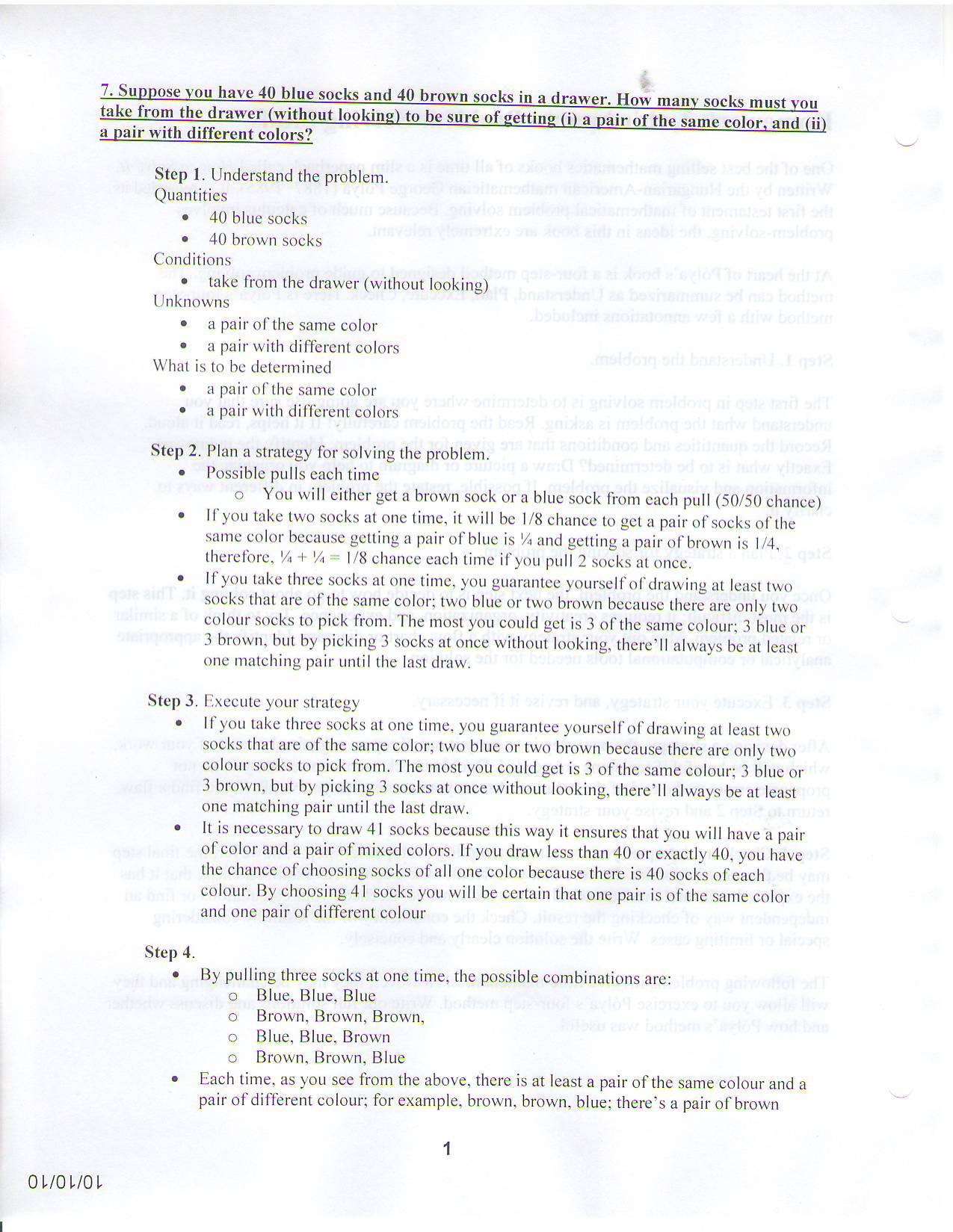
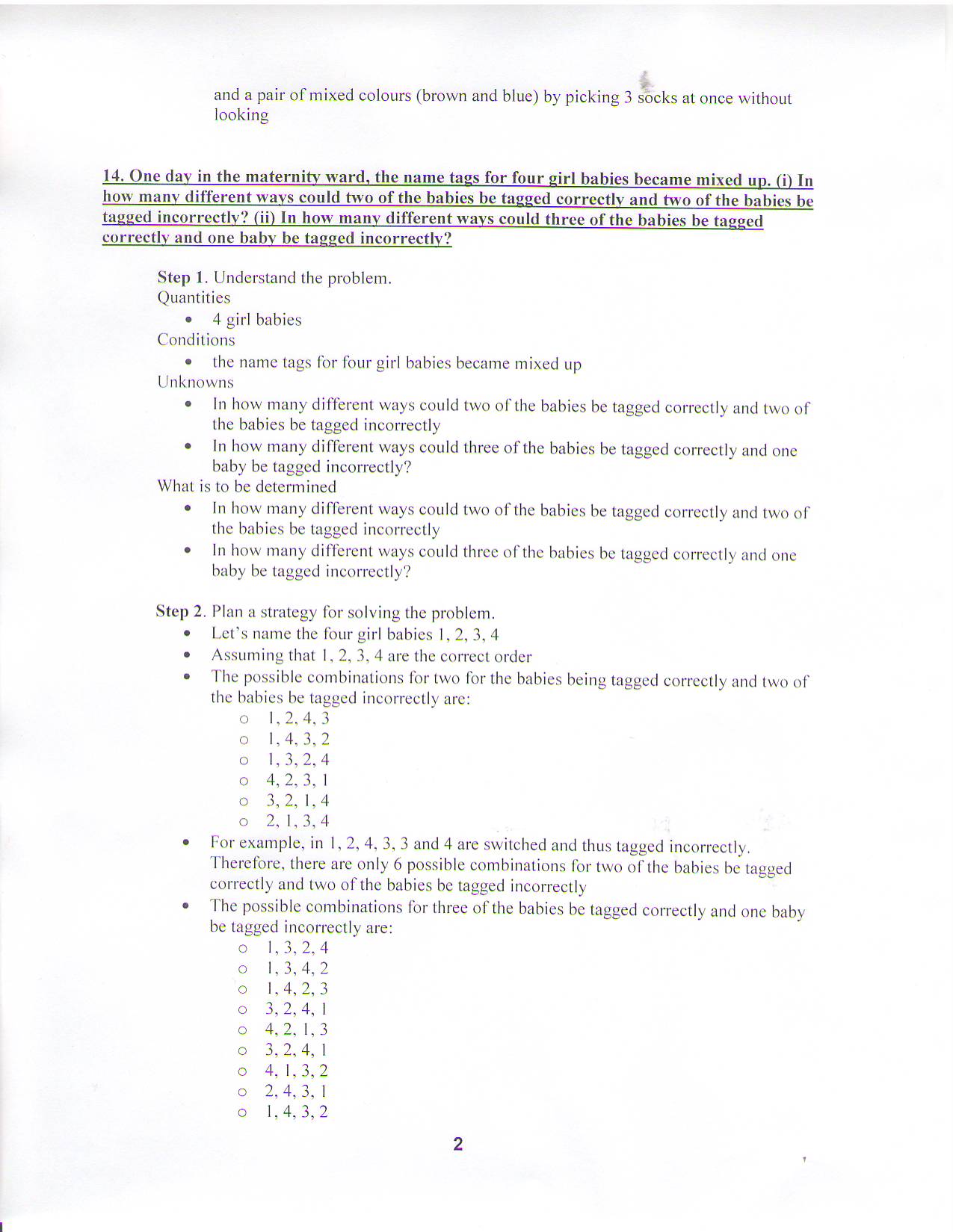


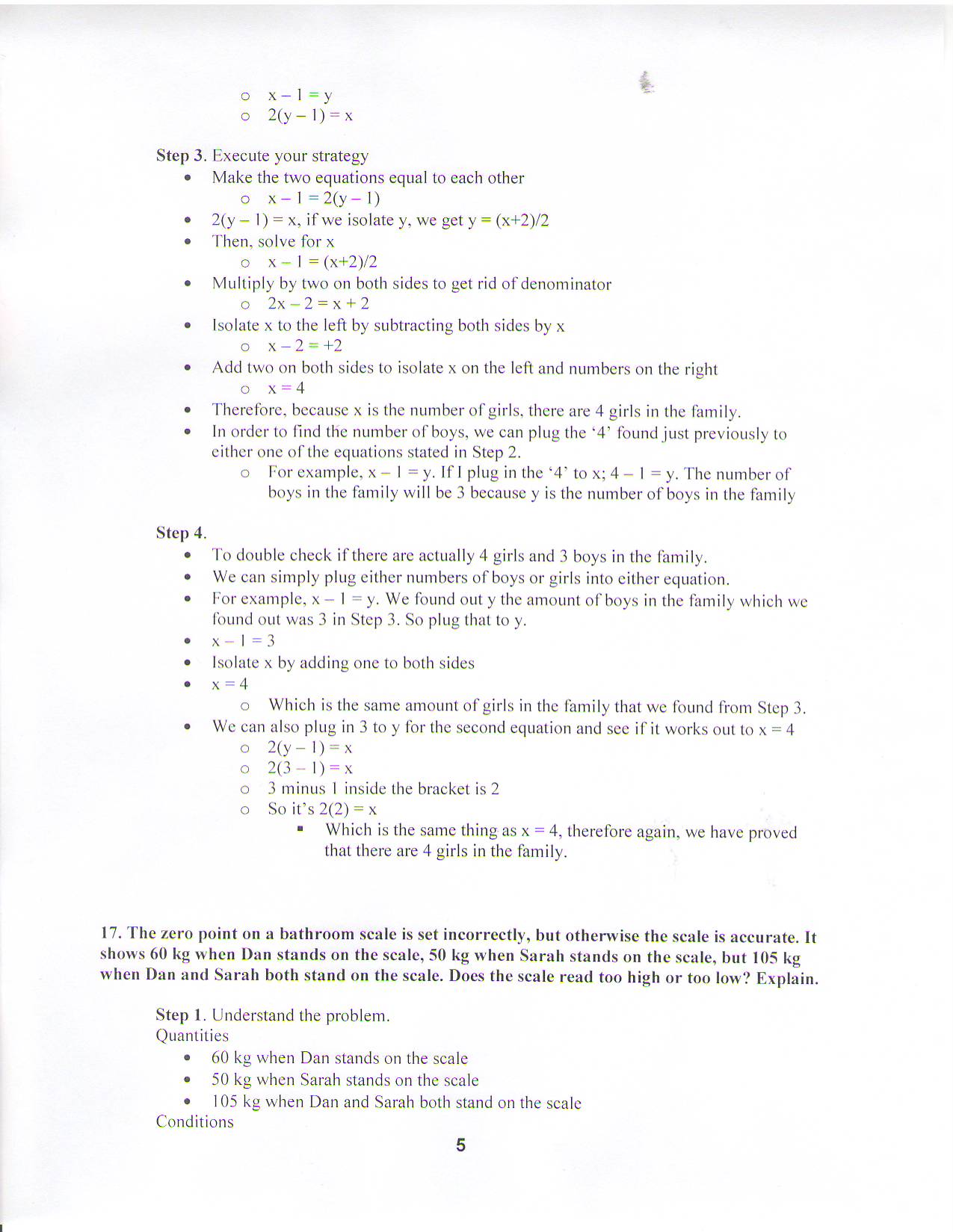
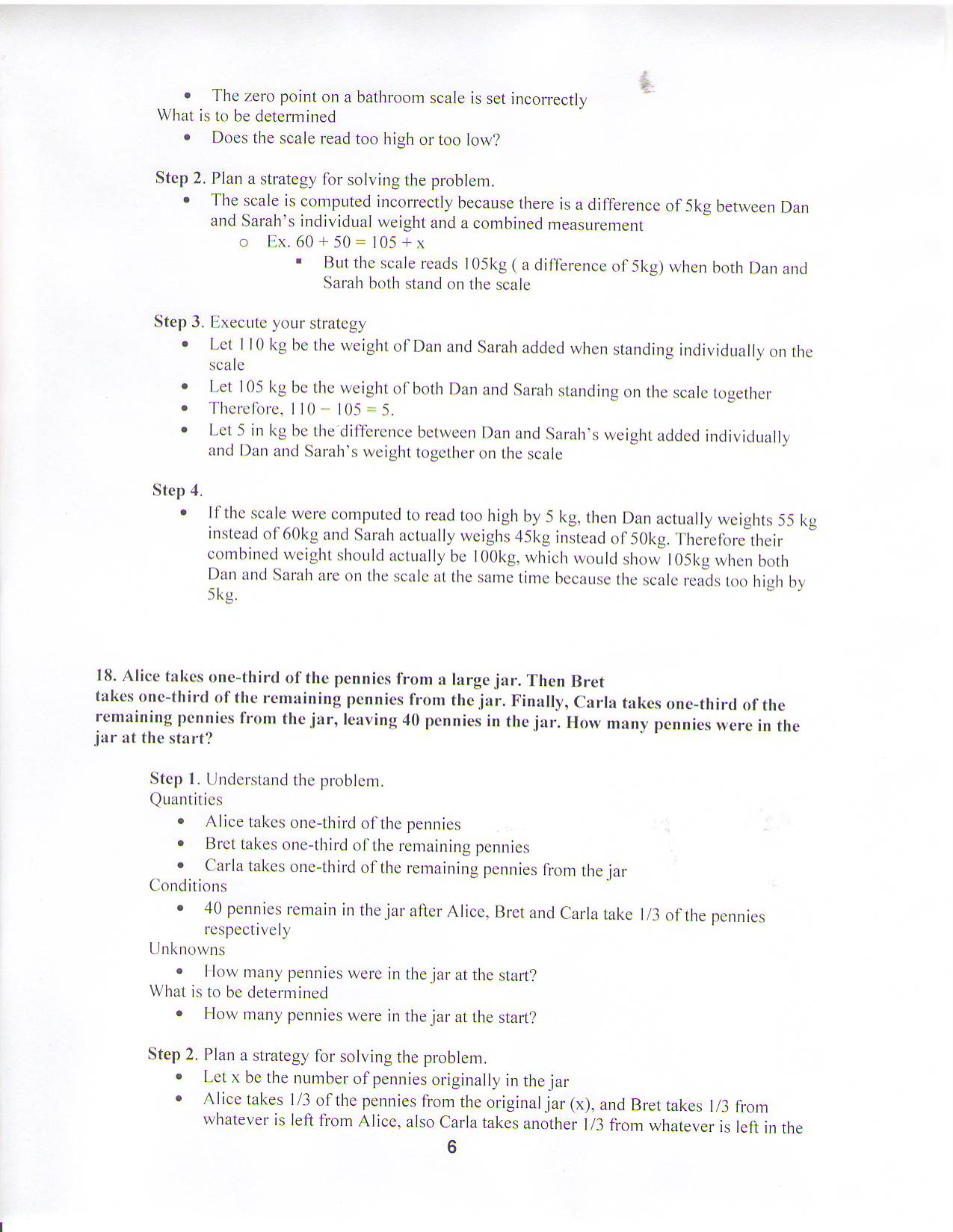
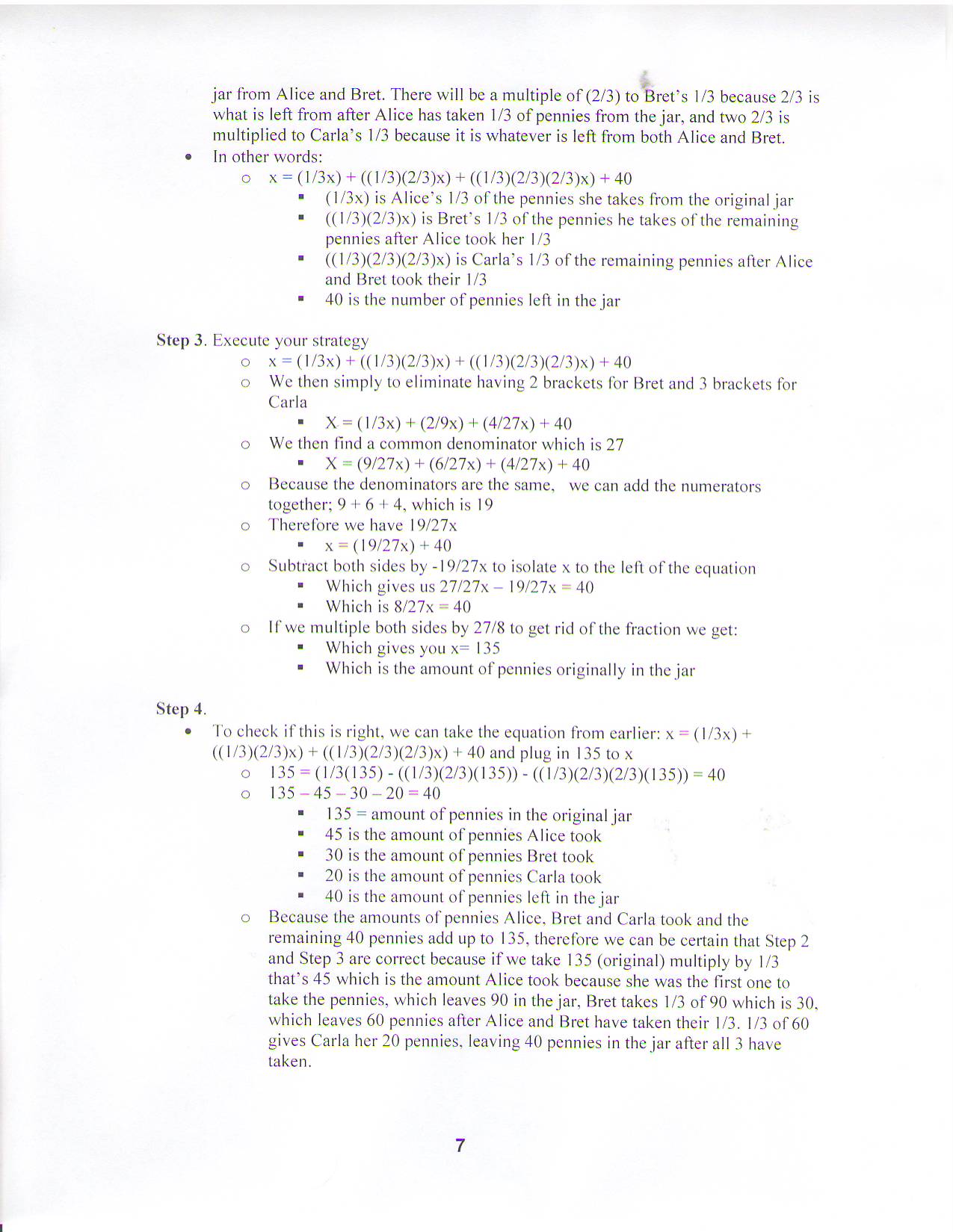
Question 19
Question 20
20. Of two clocks next to each other, one runs 5 min per hour fast and the other runs 5 min per hour slow. At midnight the clocks show the same time. At what time are they are one hour apart?
Quantities and Conditions:
1 clock is 5 minutes per hour fast
1 clock is 5 minutes per hour slow
To be determined:
The time at which the two clocks are exactly 1 hour apart.
Strategy
The clocks show the same time, 12:00am, and we can use this as our starting point to determine when the two clocks will be exactly one hour apart.
Since we know that the two clocks are inversely fast or slow to one another (when clock 1 is 40 minutes ahead, clock 2 will be 40 minutes behind), we know that at the point when the two clocks will be 1 hour apart the slow clock will be 30 minutes slow and the fast clock will be 30 minutes fast. Therefore, we need to only calculate when one clock is 30 minutes fast.
Results Interpretation:
Let F = how ahead clock 1 is.
F = 5x (since the clock is 5 minutes ahead for every hour)
Since we need to calculate the value of x when the clock is ahead 30 minutes, let F = 30.
30 = 5x (isolate x)
x = 6
We can check this answer using a table.
Clock 1 Clock 2 12:00am 12:00am 1:05am 12:55am 2:10am 1:50am 3:15am 2:45am 4:20am 3:40am 5:25am 4:35am 6:30am 5:30am (the clocks are one hour apart 6 hours after midnight at the actual time of 6:00am)
Therefore, the clocks will be one hour apart when the time is 6:00am, 6 hours past midnight.
Question 21
21. Sven placed exactly in the middle among all runners in a race. Dan was slower than Sven, in 10th place, and Lars was in 16th place. How many runners were in the race?
Quantities and Conditions:
Sven placed in the middle among all the racers
Dan was slower than Sven and placed 10th
Lars placed 16th
To be determined:
The total amount of runners in the race
Strategy:
Sven placed exactly in the middle among all the runners in the race. To do so, there must be an odd number of racers since if there were an even number of racers, Sven would either have placed in the first half or the last half of the total racers. We know that there are more than 16 racers since Lars placed 16th and the total number of racers cannot be 16 since Sven cannot have placed "in the middle" of all the racers if there were only 16 racers (16 is an even number).
Results Interpretation:
Knowing that Dan was slower than Sven, in 10th place, we can figure that Sven must have placed between 1st and 10th place. To have placed in the middle of all the racers, at a place lower than 10, then Sven must have placed 9th. To find the total number of racers, we subtract 1 from Sven's place and add it to his position.
Let S represent Sven's place Let T represent the total number of racers
T - S = S - 1 (isolate T)
T = 2S - 1
T = 2(9) - 1 (substitute S)
T = 17
1,2,3,4,5,6,7,8,9,10,11,12,13,14,15,16,17
Therefore, the total number of runners in the race is 17.
Question 22
22. During a vacation, it rained on 13 days, but when it rained in the morning, the afternoon was sunny, and every rainy afternoon was preceded by a sunny morning. There were 11 sunny mornings and 12 sunny afternoons. How long was the vacation?
Quantities and Conditions:
Total number of sunny mornings is 11
Total number of sunny afternoons is 12
Total number of rainy days is 13
Every rainy afternoon must be preceded by a sunny morning
Every rainy morning must be followed by a sunny afternoon
To be determined:
The total number of days of the vacation
Strategy:
Find equations that correspond to the amount of rainy afternoons, rainy mornings, and days when it didn't rain at all. Since a single day of the vacation never had a rainy morning AND a rainy afternoon, we can assume that every rainy morning and every rainy afternoon accounts for 1 day.
Rainy afternoons + rainy mornings + days when it didn't rain at all = total number of vacation days
Results Interpretation:
Let x = rainy mornings let y = rainy afternoons
Let z = the days it was sunny all day let T = total days of vacation
(1) x + y = 13 (since it only rained a total of 13 days) (2) y + z= 11 (since every rainy afternoon was preceded by a sunny morning) (3) x + z = 12 (since every rainy morning was followed by a sunny afternoon) (4) x + y + z = T
SOLUTION:
(1) x + y = 13 (isolate x) (5) x = 13-y substitute (5) into (3) (13-y) + z = 12 (isolate z) z = 12+y-13 (6) z = y-1 Substitute (6) into (2) y + (y-1) = 11 2y = 12 (7) y = 6 Substitute (7) into (2) 6 + z = 11 (8) z = 5 substitute (8) into (3) x + 5 = 12 (9) x = 7 Finally, substitute (7), (8), and (9) into (4) 6 + 5 + 7 = T T= 18
Therefore, the total number of vacation days was 18 days.
Question 23
23. Suppose you overhear the following conversation: Paul: How old are your three children? Paula: The product of their ages is 36 and the sum of their ages is the same as today's date. Paul: That is not enough information. Paula: The oldest child also has red hair. If you were Paul could you determine the ages of Paula's children? Explain.
Quantities and Conditions:
Given the product of the 3 ages of the children: 36
The sum of the children's ages cannot exceed 31
There is only 1 eldest child
To be determined:
The ages of Paula's children
Strategy/Interpretation of Results:
We know that Paula has 3 children and the product of their ages is 36. To determine their ages, we first have to find three numbers whose product give us 36. Since we also know that the sum of their ages is a day of the month, we know that the sum of the three numbers cannot exceed 31.
Factors of 36 Sum of the factors 3 x 4 x 3 10 6 x 2 x 3 11 9 x 2 x 2 13 6 x 6 x 1 13 9 x 4 x 1 14 12 x 3 x 1 16 18 x 2 x 1 21 36 x 1 x 1 38
We cannot solve this problem past this point since we do not know "today's date" as stated by Paula. However, we can rule out two sets: (36,1,1) and (6,6,1). (36,1,1) cannot be a solution to this problem because the sum of their ages is a date in the month and the sum of this set, 38, is not a date of the month. (6,6,1) cannot be the solution since Paula states "the oldest child has red hair", hinting that there is only one eldest child.
Question 24
24. Two candles of equal length were lit at the same time. One candle took 6 hr to burn out and the other candle took 3 hr to burn out. After how much time was one candle exactly twice as long as the other candle?
Quantities and Conditions:
Both candles were lit at the same time but one burned twice as fast as the other. One candle took 3 hrs to burn while the other took 6 hrs.
To be determined
The amount of time when one candle was exactly twice as long as the other candle
Strategy:
Derive a chart with reference to the length and the speed at which each candle was burning. If we assume that the two candles were burning at a constant rate during the entire time they were lit, then we know that one candle had twice the speed of burning than the other. If we assume that one candles were 24cm (divisible by 3 and 6) in the beginning, we can find a solution to the time when one candle was half the length of the other. We can assume this without tampering the results because we only need relative velocities to find the point at which one candle was twice the length of the other. Any assumption in length can be made as long as both candles burn at a constant rate and one candle burns out at the end of 3 hrs and the other burns out at the end of 6 hrs.
Results Interpretation:
Find the velocity at which each candle was burning. Let L = 24cm
At a length of 24cm, C burned at a rate of 24cm/6hrs = 4cm/hr
At a length of 24cm, D burned at a rate of 24cm/3hrs = 8cm/hr
time Length of C Length of D 1hr 20cm 16cm 2hr 16cm 8cm 3hr 12cm 0cm 4hr 8cm - 5hr 4cm - 6hr 0cm -
According to our observations, the time at which one candle was twice the length of the other is at 2 hours, when candle C was two times the length of candle D.
Question 25
25. Two candles of length L and L + 1 were lit at 6:00 and 4:30, respectively. At 8:30 they had the same length. The longer candle died at 10:30 and the shorter candle died at 10:00. Find L.
Quantities and Conditions:
Candle 1: Length = L Time taken to burn out: 6:00-10:00= 4hrs
Candle 2: Length = L + 1 TIme taken to burn out: 4:30-10:30 = 6 hrs
Both candles had the same length at 8:30pm.
To be determined:
The value of L (the length of the shorter candle).
Strategy
Find equations for the candles relative to the amount of time they took to burn out. Isolate the amount of hours to get a value for L.
Results:
We can assume that the smaller candle is half it's length when it has been burning for 3 hours (i.e. half the total time it took to burn out).
Let x = # of hours passed
(1) L +1 = 1/6x (since it took 6 hours to burn out at a constant rate, it burns out 1/6 every hour) (2) L = 1/4x (since it took 4 hours to burn out at a constant rate, it burns out 1/4 every hour) (2) L = 1/4x (isolate x) (3)4L = x substitute (3) into (1) L + 1 = (1/6)(4L) 6L + 6 = 4L 2L = 6 L = 3
Therefore, L = 3. The length of the shorter candle is 3 and the length of the longer candle (L + 1) is 4.
Questions 10 to 15 By Philip
10. Suppose one-half of all people are chocolate eaters and one-half of all people are women. (i) Does it follow that one-fourth of all people are women chocolate eaters? (ii) Does it follow that one-half of all men are chocolate eaters? Explain.
one-half of the people are chocolate eater does not mean one-fourth of all people are women chocolate eater. It could be all chocolate eater are men of the one-half.
11. A woman, her older brother, her son, and her daughter are chess players. The worst player’s twin, who is one of the four players, and the best player are of opposite sex. The worst player and the best player have the same age. If this is possible, who is the worst player?
A woman= w w's older brother = WOB WOB's Son= WOBS WOB"S Daughter= WOBD
The worest player could be either WOBS or WOBD, since they are opposite sex and the child of WOB. W and WOB are not twins.
12. A Manhattan fellow had a girlfriend in the Bronx and a girlfriend in Brooklyn. He decided which girlfriend to visit by arriving randomly at the train station and taking the first of the Bronx or Brooklyn trains that arrived. The trains to Brooklyn and the Bronx each arrived regularly every 10 minutes. Not long after he began his scheme the man's Bronx girlfriend left him because he rarely visited. Give a (logical) explanation.
since we do not have the timetable for the trains's schedules, and we have no idea when Mahattan would be at the station, so there is no approximation answer for this question.
13. If a clock takes 5 seconds to strike 5:00 (with 5 equally spaced chimes), how long does it take to strike 10:00 (with 10 equally spaced chimes)?
since it will take 5 seconds to strike 5:00, it will take 5 hours plus the 5 seconds to strike 10:00 if we are calculating in 24:00 timing.
14. One day in the maternity ward, the name tags for four girl babies became mixed up. (i) In how many different ways could two of the babies be tagged correctly and two of the babies be tagged incorrectly? (ii) In how many different ways could three of the babies be tagged correctly and one baby be tagged incorrectly?
(i) If two babies are tagged correctly then there must be two babies tagged incorrectly since there are only 4 babies. There would be 6 ways of different tagging. A=Baby1 B=Baby2 C=Baby3 D=Baby4
After timing all the possible ways and get rid of the existed group. we left
AB AC AD BC BD CD
so, there are six ways the babies could tagged incorrectly.
(ii) since there are four babies, so the chance of one baby tagged incorrectly would be one over four babies.
15. Alex says to you, “I'll bet you any amount of money that if I shuffle this deck of cards, there will always be as many red cards in the first half of the deck as there are black cards in the second half of the deck.” Should you accept his bet?
I should accept this bet.
There are 52 cards in the deck without the jokers. So there are 26 cards of black and red. The odds of getting even of black and red on the first half of the deck and the bottom is:
(52*51*50....26)/(1*2*3*4......26)
with no further calculation, we can assume this is a no-brain bet.